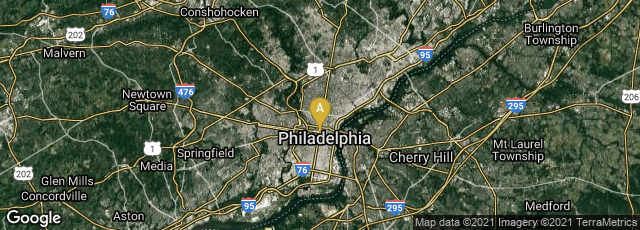This was a book that tended to get significant use. For example, the binding on one of my copies is so worn that the gold stamping on the spine has become almost invisible, and the very unusual and ornate design may be easily missed. Notice how the top of this design incorporates a version of the Hoe Eight Feeder (or Eight Cylinder) Type Revolving Printing Machine, and on the bottom we see the Menamin & Ringwalt printer's mark adapted from the original printer's mark used in the 15th century by Fust and Schoeffer. If you enlarge the image you can read their motto, supposedly a translation from the German, "God Greet the Art."
This lithograph includes images of virtually all aspects of the hot type casting and composing process, including, electrotyping in the upper right corner and stereotyping in the lower right corner. In the left lower corner we see punch-cutting. The center of the image attempts to illustrate the various stages of type-casting using a type-casting machine as described in detail in the text.
This article is the best explanation for the very limited success of typesetting machines up to 1871 that I have seen in the literature of the period. Whether any actual examples of the Alden machine illustrated have actually survived may not be known. The machine appears to be more compact than others, and unlike most machines it seems not to have used gravity to feed the metal type. According to p. 480 (which follows) the machine "has been in practical use, by Messrs. Appleton, the New York publishers, on book-work, for several years."
Here Ringwalt lays out more issues with the attempts at mechanizing the typesetting and distributing processes and lists patents granted on the topic to date. Note that the pioneer inventor, William Church, did not patent his machine in the U.S.
Brown's type distributing machine is illustrated here. In the text on this page Ringwalt indicates that 10 typesetting machines of the Mitchell design had been used in the production of Appleton's Cyclopaedia published in 1861.
Ringwalt's article on the O.S. Brown typesetting and distributing machine illustrated here explains that the machine was just introduced. From this article we may conclude that the cost of typesetting was a stumbling block in reducing publishing costs, and as I have quoted in the text to the note on his book, Ringwalt believed that a cash prize would motivate inventors to solve this problem.


A: Philadelphia, Pennsylvania, United States
Among the most comprehensive encyclopedias of printing published to 1871 was John Luther Ringwalt's American Encyclopedia of Printing co-published in Philadelphia by printer Robert S. Menamin and the editor, writer John Luther Ringwalt, and J.B. Lippincott. Though it drew, of course, on prior works, I cannot think of a more comprehensive single volume reference work on all aspects of printing and book production published in the English language prior to this date. The work appears to have been intended both for printers and for the interested public.
Many aspects of this work suggest that it was, at least partly, a labor of love. These include the very liberal number of fine illustrations, an example of embossed printing for the blind actually typeset by a blind typesetter, examples of watermarks, etc. I have attached images of some of the more unusual illustrations in the book as well as Ringwalt's long article on the pros and cons of mechanized typesetting--the most comprehensive summary of the situation in that challenging aspect of printing that I have seen published up to 1871. From his article on Brown's Patent Type-Setting and Distributing Machinery", a device that had been introduced in 1870, we learn that Ringwalt believed that reducing the cost of typesetting was a main desideratum for American book production. From p. 82 I quote:
"Type setting should be so cheap that publishers can print books and papers in this country, and sell them at the low prices that now obtain in England. A London house has printed the Pilgrims Progress, in clear type, on good paper, so that the book can be retailed for a penny. News and illustrated papers are sold in England at nearly proportionately low rates. We have not as yet, reached this point in this country, although in proportion to our population, there are more readers here than in any other nation on the globe. We want the means of supplying the demand for reading matter. The inventive talent of our country produced the steamboat, the cotton-gin, and the electric telegraph. Its fully equal to the production of the perfect type-setting machine, which shall rapidly and cheaply do the entire composition of the whole country. Nothing else so profitably suggests to the mind of the American inventors. We invite the press of the country to join in subscribing for a prize which shall be worthy the attention and competion of every skillful inventor in the country. The prize shall be less than half a million dollars; and, if the leading newspapers in the country can be induced to combine in such an offer, the Worlind will gladly head the list with $25,000 as its own subscription. To the successful man, who produces the called-for instrument, a quarter of a million dollars will galdy be given by the publishers of the country. The rest of the prize should be distributed to the second, third, fourth, and fifth best machine."
Information by Menamin and Ringwalt is found primarily in the successor encyclopedia of printing published in New York in 1894: American Dictionary of Printing and Bookmaking edited anonymously by Wesley Washington Pasko.